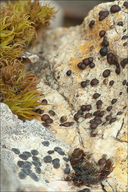date of photo Apr 5, 2017
latitude 46.36135 longitude 13.69849
View on Google Maps.
location
Lower Trenta valley, right bank of river Soča; between villages Soča and Trenta; Skokar's ravine; upstream from the trail from Trenta 2b to Strgulc abandoned farm house, Soča 47, East Julian Alps (Posočje, Slovenia)notes Syn.: Biatorella flava W. Johnson ex A.L. Sm., Biatorella regularis (Körb.) Lettau, Lecidea pruinosa f. nuda Kremp., Lecanora glaucocarpa f. pruinosa Leight. - Habitat: Moderately inclined mountain ravine, southeast aspect; rocks and scree with sparse vegetation; calcareous, colluvial ground; full sun, dry place; exposed to direct precipitations; average precipitations ~ 3.000 mm/year, average temperature 6-8 deg C, elevations 680 m (2.250 feet), alpine phytogeographical region. - Substratum: calcareous rocks. - Comment: This lichen, which is quite variable, grows on calcareous rocks. The Sarcogyne regularis has multi-spore asci, which contain more than 100 spores each. The species is almost impossible to be distinguished from very, very similar Clauzadea monticola in the field, But the latter has 8-spored asci. Calcareous rock in Trenta (limestone or dolomite) has on some rare places inclusions of much harder rock than surrounding. The intrusions look crystalline and in parts almost as quartz and are colored yellowish-ochre or reddish. But, HCL test proved they were also calcareous. Lecidea type apothecia were strictly limited to these inclusions. Hymenium is black and flat or slightly concave when dry and dark reddish-brown, like somewhat translucent, and distinctly convex. Thallus is immerged in the rock (endolithic) and practically invisible. - Spores simple, ellipsoid. Dimensions: (3,5) 3,7 - 4,7 (5,1) × (1,3) 1,7 - 2,2 (2,3) µm, Q = (1,7) 2 - 2,5 (2,8); N = 39; Me = 4,2 × 1,9 µm; Qe = 2,2. Asci dimensions: (53) 57,1 - 77 (79,6) × (10,6) 12,7 - 16,7 (21,4) µm, Q = (3,6) 3,9 - 5 (6); N = 26, Me = 66,3 × 15,2 µm; Qe = 4,4. Olympus CH20, NEA 100x/1.25, magnification 1.000 x, oil (spores); NEA 40x/0.65, magnification 400x (all the rest), in water, cotton blue, fresh material. AmScope MA500 digital camera.- Ref.: (1) F.S. Dobson, Lichens, The Richmonds Publishing Ca.LTD (2005), p 400. (2) C.W.Smith, et all, The lichens of Great Britain and Ireland,The British Lichen Society,(2009), p 830. (spores: 3-5(6)/1.5-2, asci: 60-85/14-18) (3) I.M. Brodo, S.D. Sharnoff, S.Sharnoff, Lichens of North America, Yale Uni. Press (2001), p 650. (4) V. Wirth, Die Flechten Baden-Württembergs, Teil. 2., Ulmer (1995), p 844. (spore 3-6/1,5-2) (5) https://lichenportal.org/cnalh/taxa/index.php?taxon=53070&clid=1058 (accessed April 17. 2021); spore: 3-5(-6) x 1.5-2(-2.5) µm, asci: 60-85 x 14-18(-27) µm, apothecia (0.2-)0.5-1(-1.3) mm (6) http://www.dorsetnature.co.uk/pages-lichen/lch-38.html (accessed April 17. 2021); spore: 3-5(-6) x 1.5-2 µmcamera Nikon D700 / Nikkor Micro 105mm/f2.8
contributor's ID # Bot_1046/2017_DSC7221 photo category: Fungi - lichen
|
